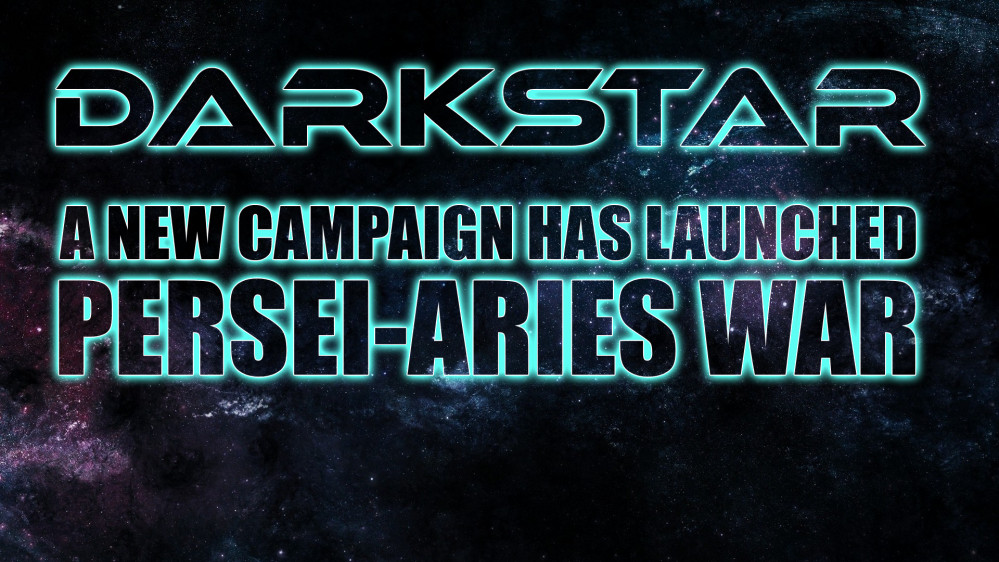
Persei-Aries War Resumes
American-Japanese skirmish at Katajima (Zeta Hercules)
FROM: ADVISORY OFFICE, UNITED NATIONS REGIONAL COLONIAL CENTER
013:05 SOL GMT, 15 MARCH 2522
BREAKAUTH: 181072.18J
CLEARANCE: NATIONAL COMMAND AUTHORITY
SUBJ: AMERICAN RAID ON KATAJIMA (Kyokko Bijin – Zeta Hercules A3)
The Americans may have signed a separate peace with the British in the Treaty of Zubrin, but the United States Navy has never completely sheathed the sword in the Hercules Rim. Open hostilities persist with the Arab League and especially the Japanese Empire, a fact brought to sharp relief when a small American raiding force emerges from an accelerated Darkstar Wave in the inner orbital zones of the Kyokko Bijjin colonies (Zeta Hercules), intent of destroying a small array of orbital refineries and surveillance outposts over the terrestrial world of Katajima (Zerta Hercules A3).
Latest American intelligence had reported the orbital zones of this particular planet to be empty. Accordingly, Captains Matthew Spencer and Zachary Irons (commander, Task Force Oriskany and Liberty respectively) thought this strike would be an ideal opportunity for some of their junior commanders to accrue some combat command experience. Accordingly, all the newer, less experienced warships and commanders of these two task forces were sent together to carry out what was supposed to be a routine “smash-and-dash” raid.
Of course, this intelligence turned out to be woefully out of date. Perhaps warned by the mysterious “Red Kitsune,” the enigmatic Japanese spy (or spy network) that allowed them to anticipate so many battles in the recent Duchess Annabel’s War, the Kyokko Bijin Prefecture command has a small force ready and waiting for the Americans in low orbit over Katajima.
This force turns out to be only two ships, the old Hokkaido class light cruiser IJN Tatakawa and the Kagoshima class aerospace strike carrier Nagashima, both from the elite and decorated Naginata cruiser strike squadron under the flag of Commodore Hiromi Ozawa. Now elite or not, two ships cannot protect or even watch the orbital approaches of an entire Earth-analog planet, so the Takakawa stays near the refineries while the Nagashima sets high-speed orbital course, her aerospace fighters, bombers, and scouts ranging all across Katajima hoping at least to provide some warning of an American approach.
The Japanese plan works … somewhat. These are destroyers, frigates, and corvettes of the Oriskany and Liberty task forces, remember, their Darkstar FTL drives extensively upgraded. As a result, they’re able to set a high-speed, high-accuracy jump directly into the heart of the Kyokko Bijin binary star system, rocketing straight into the low orbital zones of Katajima. But another way, despite the Japanese being forewarned, the sheer speed of American strike still gives them some degree of tactical surprise nonetheless.
The end result, the American strike meets only the Takakawa, supported only by the handful of Nagashima fighters and bombers that happen to be close enough to reach the Takakawa as the Americans make their final approach. It’s a small, high-speed skirmish, fought between “second-tier” support elements of some of the most elite and renowned naval formations operating in Known Space today.
[In other words, I am running a small game to “reawaken” the warships and commanders in my Japanese task force, and to give my American “noobs” a little experience and help them catch up to the superstars like USS Oriskany, Liberty, Tarawa, Valley Forge, and Northampton.]
RAID VICTORY CONDITIONS (127 points)
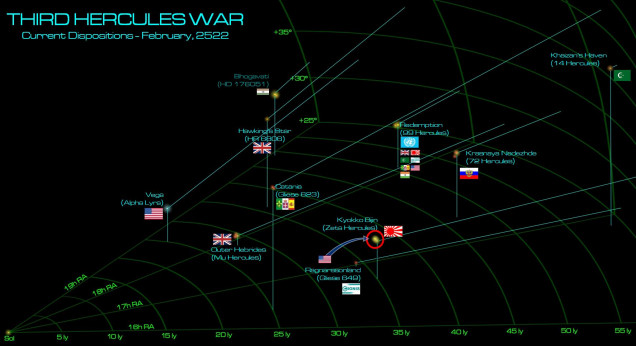 The general situation of the Third Hercules War in March, 2522. The Americans, perhaps eager to assure their former “Coalition of Eagles” allies that they are in fact not lap dogs of the British (despite the recent US Navy battle fought in service of the British at Mu Hercules, part of the mutual military assistance clauses in the Treaty of Zubrin), are eager to strike against the Renkei Alliance (so long as they don’t hit the British, again . . . per the Treaty of Zubrin). Accordingly, the Americans have staged this small task force with their allies in the Corporate Consortium holdings of Ragnarssonland (Gliese 629, formerly of Imperial Prussia), poised to strike amidst the third planet of the primary star of the Zeta Hercules binary system, Katajima (Zeta Hercules A3).
The general situation of the Third Hercules War in March, 2522. The Americans, perhaps eager to assure their former “Coalition of Eagles” allies that they are in fact not lap dogs of the British (despite the recent US Navy battle fought in service of the British at Mu Hercules, part of the mutual military assistance clauses in the Treaty of Zubrin), are eager to strike against the Renkei Alliance (so long as they don’t hit the British, again . . . per the Treaty of Zubrin). Accordingly, the Americans have staged this small task force with their allies in the Corporate Consortium holdings of Ragnarssonland (Gliese 629, formerly of Imperial Prussia), poised to strike amidst the third planet of the primary star of the Zeta Hercules binary system, Katajima (Zeta Hercules A3). The Americans cut low over Katajima’s upper atmosphere, setting a high-speed approach toward the one Japanese warship in the area, the aged (but elite and heavy-upgraded) light cruiser Takakawa (Captain Koji Ryoko). The Americans are led by Commander Rachel Collingsworth aboard the Valcour-class destroyer USS Cowpens, with the Shepard class frigates John Young and Ronald Evans. In the vanguard is the deadly little Mako-class torpedo corvette USS Daggerfish, now under the command of Lt. Commander Lewis Knight (Daggerfish’s former commander Priscilla Wolfe has been promoted to take command of the Valcour-class destroyer USS Hancock). The Americans have to peel up fro the planet a little in order to get torpedo locks on the Takakawa, which has cut even closer to the Katajima atmosphere and presented a broadside against the approaching foe. While the Americans launch a terrifying spread of deadly-accurate Mark 48 gravitic torpedoes, the Takakawa kicks off with a withering broadside that even at this range (3600 kilometers) hits the Daggerfish perfectly on her bow, caving in her foc’s’le, destroying both her torpedo arrays, exploding her magazines, and hitting the bridge. Just that fast, in the very first salvo of the skirmish, the Americans have lost their first warship.
The Americans cut low over Katajima’s upper atmosphere, setting a high-speed approach toward the one Japanese warship in the area, the aged (but elite and heavy-upgraded) light cruiser Takakawa (Captain Koji Ryoko). The Americans are led by Commander Rachel Collingsworth aboard the Valcour-class destroyer USS Cowpens, with the Shepard class frigates John Young and Ronald Evans. In the vanguard is the deadly little Mako-class torpedo corvette USS Daggerfish, now under the command of Lt. Commander Lewis Knight (Daggerfish’s former commander Priscilla Wolfe has been promoted to take command of the Valcour-class destroyer USS Hancock). The Americans have to peel up fro the planet a little in order to get torpedo locks on the Takakawa, which has cut even closer to the Katajima atmosphere and presented a broadside against the approaching foe. While the Americans launch a terrifying spread of deadly-accurate Mark 48 gravitic torpedoes, the Takakawa kicks off with a withering broadside that even at this range (3600 kilometers) hits the Daggerfish perfectly on her bow, caving in her foc’s’le, destroying both her torpedo arrays, exploding her magazines, and hitting the bridge. Just that fast, in the very first salvo of the skirmish, the Americans have lost their first warship. As the Daggerfish spirals burning across the Katajima sky, the rest “Battlegroup Cowpens” presses the attack. For a moment there is hope, the remaining American torpedoes streak toward the Takakawa, which only knocks a few of them down with her mass drivers. Japanese Ki-202 "Hien" Flying Swallow scouts fail to knock down any, and ten warheads hit the Takawaka’s starboard quarter shields. But these shields are upgraded, and only three Mark 48s scatter themselves across Takakawa’s hull. The USS Ronald Evans bravely sets herself up fro a broadside on the Takakawa (a ship four times her size), and manages to hit Takakawa’s sensors and maneuvering thrusters, but is smashed through the bridge by the Takakawa’s broadside of 6-gigawatt rail guns and powerful EPCs. The Americans have now lost a SECOND warship, but at the least the aerospace / ordinance strike of A9M "Kataka" (Fire Hawk) fighters, B7N "Tenrai" (Heavenly Thunder) bombers, and Ki-45 “Kiryu” (Dragon Slayer) torpedoes has been broken up before it could seriously damage the frigate John Young, while American “Hawkeye” manage to down one Japanese bomber.
As the Daggerfish spirals burning across the Katajima sky, the rest “Battlegroup Cowpens” presses the attack. For a moment there is hope, the remaining American torpedoes streak toward the Takakawa, which only knocks a few of them down with her mass drivers. Japanese Ki-202 "Hien" Flying Swallow scouts fail to knock down any, and ten warheads hit the Takawaka’s starboard quarter shields. But these shields are upgraded, and only three Mark 48s scatter themselves across Takakawa’s hull. The USS Ronald Evans bravely sets herself up fro a broadside on the Takakawa (a ship four times her size), and manages to hit Takakawa’s sensors and maneuvering thrusters, but is smashed through the bridge by the Takakawa’s broadside of 6-gigawatt rail guns and powerful EPCs. The Americans have now lost a SECOND warship, but at the least the aerospace / ordinance strike of A9M "Kataka" (Fire Hawk) fighters, B7N "Tenrai" (Heavenly Thunder) bombers, and Ki-45 “Kiryu” (Dragon Slayer) torpedoes has been broken up before it could seriously damage the frigate John Young, while American “Hawkeye” manage to down one Japanese bomber.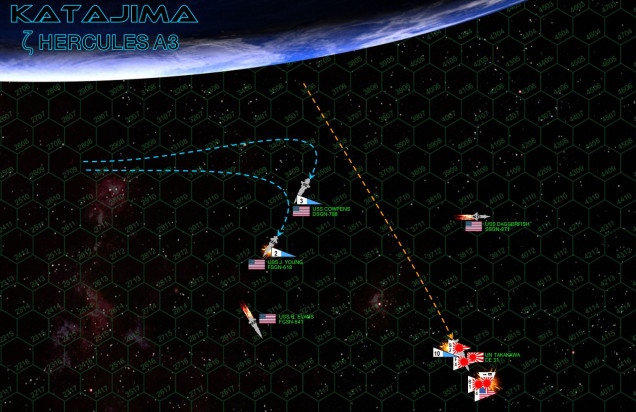 The Takakawa has been badly damaged along her starboard quarter, and now raises maximum steam to leave the battle area. If she can break off the immediate engagement yet remain operational in the Katajima area, the Americans (who have already lost two ships and will be spending the next hours or even days in rescue and recovery operations). The Americans fail crucial initiative checks, and the Takakawa’s move catches them largely flat-footed. There is a despairing attempt to hit the Takakawa with a second reduced spread of torpedoes, but Captain Ryoko has wisely recalled his fighters to help shoot down the incoming American warheads. Only one additional warhead gets through, along with a single EPC hit from the John Young. It hits Takakawa’s starboard reactors, but it won’t be enough to leave her crippled.
The Takakawa has been badly damaged along her starboard quarter, and now raises maximum steam to leave the battle area. If she can break off the immediate engagement yet remain operational in the Katajima area, the Americans (who have already lost two ships and will be spending the next hours or even days in rescue and recovery operations). The Americans fail crucial initiative checks, and the Takakawa’s move catches them largely flat-footed. There is a despairing attempt to hit the Takakawa with a second reduced spread of torpedoes, but Captain Ryoko has wisely recalled his fighters to help shoot down the incoming American warheads. Only one additional warhead gets through, along with a single EPC hit from the John Young. It hits Takakawa’s starboard reactors, but it won’t be enough to leave her crippled. 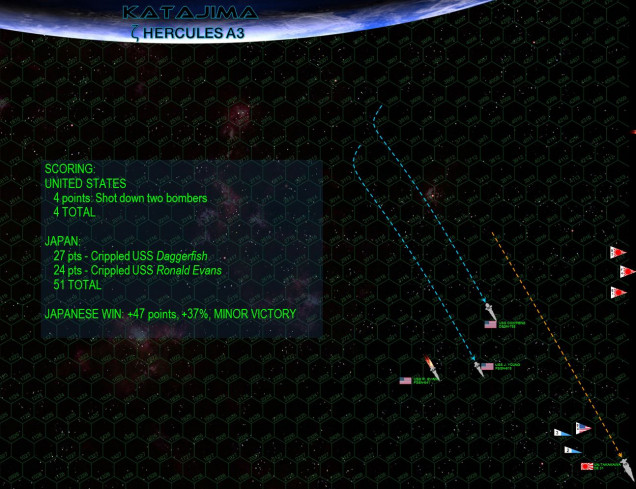 The Takakawa makes it off the table, seriously damaged by definitely still operational. The combined threat of Takakawa’s return (once she patches some plate over her starboard quarter), plus the rapid approach of the Nagashima and the rest of the elite “Donryu Kotukai” (Storm Dragon Naval Air Group). The Americans have had a corvette and frigate crippled, and have shot down just two bombers to show for it. It’s a humbling loss to be sure. Obviously, this was a solitaire game, so neither player was “better” than the other, it came to raw luck. The Takakawa hammered the Daggerfish right out of the battle with the opening long-range salvo, which took her eight +2 torpedoes out of the American spread, which meant that only ten warheads hit the Takakawa on Turn 2 instead of 18 (against a shielding of 6, this would have been six torpedoes instead of three). Its damned possible that Takakawa would have been crippled right there, even if Daggerfish had been crippled but sixty seconds later. Then the Americans failed a crucial initiative check, the Takakawa rolled a “6” on her second mass driver check ... It simply wasn’t the Americans’ day.
The Takakawa makes it off the table, seriously damaged by definitely still operational. The combined threat of Takakawa’s return (once she patches some plate over her starboard quarter), plus the rapid approach of the Nagashima and the rest of the elite “Donryu Kotukai” (Storm Dragon Naval Air Group). The Americans have had a corvette and frigate crippled, and have shot down just two bombers to show for it. It’s a humbling loss to be sure. Obviously, this was a solitaire game, so neither player was “better” than the other, it came to raw luck. The Takakawa hammered the Daggerfish right out of the battle with the opening long-range salvo, which took her eight +2 torpedoes out of the American spread, which meant that only ten warheads hit the Takakawa on Turn 2 instead of 18 (against a shielding of 6, this would have been six torpedoes instead of three). Its damned possible that Takakawa would have been crippled right there, even if Daggerfish had been crippled but sixty seconds later. Then the Americans failed a crucial initiative check, the Takakawa rolled a “6” on her second mass driver check ... It simply wasn’t the Americans’ day.




























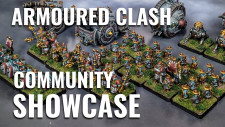











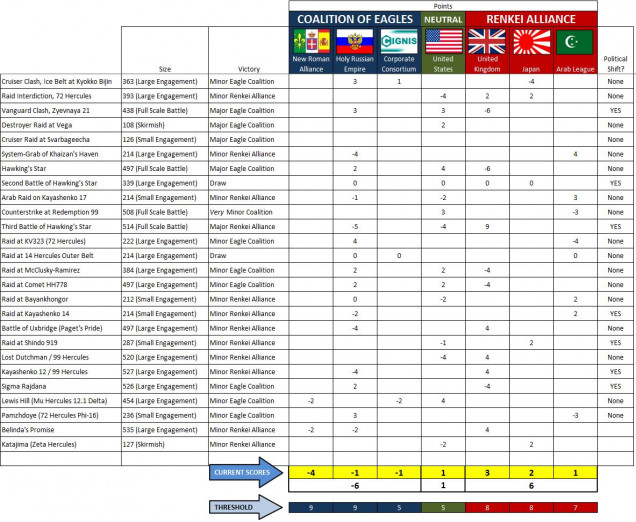

































Nice little skirmish, we just need an Arab victory now to tee up some major action
Indeed, @damon – I didn’t want people to forget the Japanese were in this war too!
Loving some of the updated visuals on these new reports. And the ever-mysterious and ever-growing legend of the Red Kitsune 🙂
Thanks, @davehawes . These are just screen shots from our live game boards, but yes … we are trying to improve the look of the planets / moons / asteroids and trying out some new fonts on the labeling, etc. The Red Kitsune indeed. Who knows what he/she/they are? Of course, I picture a stunningly-beautiful Japanese woman in an elegant red evening dress … prowling embassy dinners and state functions held aboard opulent star liners … you know, the absolute WORST kind of spy who would attract attention wherever she went. More like he’s some anonymous, dweeby mid-level accountant in… Read more »